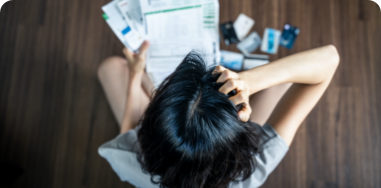Bankruptcy and Insolvency Act
Bankruptcy is one of several insolvency proceedings covered by the Bankruptcy and Insolvency act in Canada (as well as the consumer proposal and division 1 proposal).Under the bankruptcy code, any insolvent person who owes more than $1,000 to a secured creditor which they are unable to pay can apply to be declared bankrupt.
When debt problems reach a point where an individual can no longer cover the repayments, bankruptcy may be the only option. There are several alternatives to bankruptcy that should be considered to regain financial control, before filing for bankruptcy
Write off up to 80% of your unaffordable debt – Check if you qualify!
Who handles my bankruptcy petition?
Working with a Licensed Insolvency Trustee (LIT)
In Canada, bankruptcy can only be declared by Licensed Insolvency Trustees (LITs), debt professionals whose job it is to administer the bankruptcy and work with creditors on the debtor’s behalf.The individual must surrender all assets to a Licensed Insolvency Trustee (LIT) who will deal with each of their creditors to eliminate the debts.
The bankruptcy trustee will help you wipe out your debt, handle any additional payments you have to make (called surplus income payments) and do whatever is necessary to give the individual a fresh financial start.
When should I declare bankruptcy?
Declaring bankruptcy is only one of many solutions to debt management. To determine whether it’s the best option in your situation, you should consult your LIT who will outline all available solutions and which is the most effective for you.Bankruptcy could be your best option if:
- You currently owe more money than you earn.
- You cannot make the monthly debt repayments or pay your bills without accessing further credit.
- Your wages are being garnished (having money automatically taken) by one or more of your creditors.
- You are seeking relief from debt and require a fresh start.
Secured loans, where an asset is presented as collateral, will be managed by the sale of the asset; any shortfall in repayment can be dealt with in the bankruptcy.
Other debts that will not be included in bankruptcy are alimony and child support payments, court fines and penalties, and student loans unless your study ended over 7 years ago.
To file for bankruptcy, you must have debts of over $1,000. You may not lose everything you own when you file for bankruptcy, as some assets will be protected. Although personal bankruptcy goes on public record, it will not be announced in the local media in the same way as a limited company bankruptcy.
Debt Solution Finder
Discover the ideal debt solution for your needs with our debt solution finder.
The costs of bankruptcy
To file for bankruptcy, there are certain costs and fees involved, as there are with all debt relief solutions. These costs are dictated by the federal government and not your Licensed Insolvency Trustee.You are required to provide some compensation to your creditors, and also fees for the services of your LIT. The costs are variable depending on the work involved with your case.
Surplus income payments
Depending on the income of the individual, they may be required to make larger contributions to their creditors.These surplus income payments are calculated from what the Office of the Superintendent of Bankruptcy considers the minimum amount for a reasonable standard of living.
If you make over $200 more than the minimum amount in any given month, you will be made to pay half of the amount that you have exceeded the threshold by.
The bankruptcy process
The bankruptcy process takes a minimum of 9 months. There are conditions that must be adhered to for the debt to be eliminated. These will be taken into account, and the Court will determine the total timescale.- Discuss your options with your Licensed Insolvency Trustee (LIT) Your LIT will outline all other options and explain if bankruptcy is your most suitable option.
- Make an application Once you have considered your options and decided bankruptcy is the best option for you, you will complete your application.
- File for bankruptcy Your LIT will file the legal papers with the federal government. All other legal action and debt retrieval practices against you will cease at this point.
- Your creditors will be notified Your LIT will notify all creditors about the bankruptcy; they may choose to call a meeting to discuss the details in full.
- Non-exempt assets will be sold The law entitles you to keep certain belongings, and your LIT will determine which are available to be sold in order to pay towards your outstanding debt.
- You make minimum monthly payments to your LIT In some situations you will be required to make a monthly payment to your LIT, to pay for their professional services. You may also be required to make ‘surplus income payments’ if your income exceeds a certain amount.
- You will be required to attend credit counselling You must attend 2 credit counselling sessions in line with the bankruptcy process law. You will be shown ways to better manage your finances and avoid debt in future and how to rebuild your credit when your bankruptcy period is complete.
- You will be discharged from bankruptcy If you have complied with all the terms, you will be discharged and all debts involved will be cleared. Your LIT may have to prepare a final report, and you may have to attend a discharge hearing.
What happens to your assets if you declare bankruptcy?
Each province and territory has its own exemptions regarding assets. You should discuss this matter with your LIT to find out exactly how you will be affected in your situation.The biggest asset for most individuals is their home. To keep your home, you must be able to pay your LIT the amount of equity you have earned. If the equity in your home is high, bankruptcy may not be the best solution for you.
You will also be required to hand over many other assets and incomes in your bankruptcy period. These include contributions made to Retirement Savings Plans within the previous 12 months, tax refunds, lottery winnings or inheritances, and any gifts, transfers of property, or special accommodations you may have made over the last 12 months.
Here’s an example of how we can help
Let’s say you owe…
CRA Debt
$13,020.92
Canadian Tire Card
$8,244.36
TD Bank Overdraft
$1,539.09
Utilities Arrears
$760.68
CashMoney Loan
$2,302.40
Student Debt
$3,923.50
Total amount owed:
$27,790.96
Repayments reduced by 88%
Will bankruptcy filings impact my credit rating?
Bankruptcy should always be a last resort, because it will be listed on your credit report for a period of seven years.Bankruptcy will also severely affect your credit rating. When a debtor files bankruptcy and an R9 is added to their credit report, lenders will be able to view that information, making it less likely they will allow you to access credit in the future.
While bankruptcy will damage your credit, it’s likely your credit rating will already have been affected by your existing debt problems. In some cases, rebuilding your credit score after bankruptcy can be simpler than rebuilding it after defaulting on payday loans or medical bills.
Advantages of a Bankruptcy
- It is a legal process managed in accordance with the law so all harassment or aggressive debt collection will cease.
- Interest will no longer be added to any debts being paid.
- All legal action and claims from creditors will cease.
- Once discharged from bankruptcy, all unsecured debts will be eliminated.
- Wages will no longer be garnished.
- Some of your assets will be protected.
- Bankruptcy may cost less than other debt management options.
Disadvantages of a Bankruptcy
- Filing for bankruptcy negatively affects your credit rating for a period of six years.
- Bankruptcy can lead to the loss of non-essential assets.
- Bankruptcy can be expensive, with costs varying based on your income and situation.
- Bankruptcy may not be the best option if you work in certain occupations, such as finance or law enforcement.
- Bankruptcy does not discharge all debts, including alimony, child support, fines, and some student loans.
- You are required to fully disclose your finances when filing for bankruptcy.
- If you are required to file bankruptcy more than once, the negative impact on your credit is even more significant.
The alternatives to bankruptcy
There are a selection of alternatives to bankruptcy; you should always get advice from a professional debt manager or an LIT in which is the best option for your unique situation.Debt settlement
A practice that allows you to pay off a lump sum that is typically less than the total debt to settle the debt.Debt consolidation
Taking out a new, single loan to repay a number of existing debts, usually with smaller more manageable repayments over a longer term.Consumer proposals
A legal process administered by an LIT created to pay creditors a percentage of what is owed or to extend the term of repayment.Credit counselling
A process where debtors manage their debt by being better educated in budgeting methods and additional tools to reduce and repay their debt.Where can I get debt advice and more information?
Declaring personal bankruptcy shouldn’t be taken lightly as it can impact your credit rating for years to come. If you’re facing severe financial difficulty, however, it might be the best way to deal with your debt and move on with your life.If you’re financial situation is getting out of hand, we can help. A Fisher & Associates exists to help Canadians deal with their debt.
Our team of advisors will be able to explain how bankruptcy proceedings work, and whether it’s the best debt solution for you.
For impartial financial advice and a free initial consultation, talk to one of our friendly advisors today on 416-842-0040.
Write off up to 80% of your unaffordable debt
We’ve helped thousands of people, just like you, write off unsecured debt they can’t afford and enjoy a life free of pressure from the people they owe money to.
If you’re looking for help, or you’re worried about your ability to repay the debt you owe, A. Fisher & Associates is here to support you.
For free advice and guidance tailored to your financial situation, you can talk to one of our debt experts today. Give us a call for free on 416-842-0040



